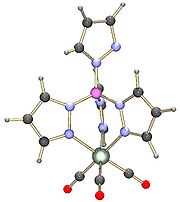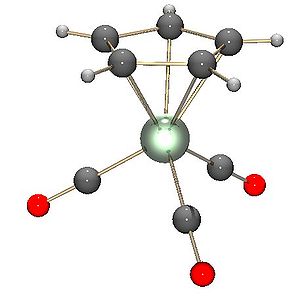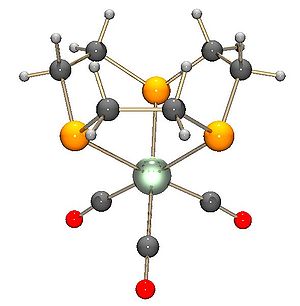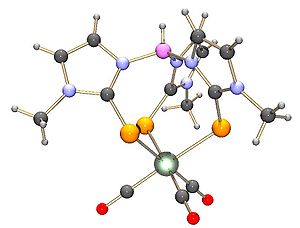
Scorpionate ligand
Encyclopedia

Ligand
In coordination chemistry, a ligand is an ion or molecule that binds to a central metal atom to form a coordination complex. The bonding between metal and ligand generally involves formal donation of one or more of the ligand's electron pairs. The nature of metal-ligand bonding can range from...
which would bind to a metal in a fac manner. The most popular class of scorpionates are the hydrotris(pyrazolyl)borates or Tp ligands. These were also the first to become popular. These ligands first appeared in journals in 1966 from the then little-known DuPont chemist Swiatoslaw Trofimenko. Trofimenko called this discovery "a new and fertile field of remarkable scope".
The term scorpionate comes from the fact that the ligand can bind a metal with two donor sites like the pincers of a scorpion
Scorpion
Scorpions are predatory arthropod animals of the order Scorpiones within the class Arachnida. They have eight legs and are easily recognized by the pair of grasping claws and the narrow, segmented tail, often carried in a characteristic forward curve over the back, ending with a venomous stinger...
; the third and final donor site reaches over the plane formed by the metal and the other two donor atoms to bind to the metal. The binding can be thought of as being like a scorpion grabbing the metal with two pincers before stinging it.
While many scorpionate ligands are of the Tp class, many other scorpionate ligands are known. For example the Tm and tripodal phosphine classes have an equally good claim to be scorpionate ligands. Many of the scorpionate ligands have a central boron
Boron
Boron is the chemical element with atomic number 5 and the chemical symbol B. Boron is a metalloid. Because boron is not produced by stellar nucleosynthesis, it is a low-abundance element in both the solar system and the Earth's crust. However, boron is concentrated on Earth by the...
atom which bears a total of four groups, but it is possible to create ligands which use other central atoms.
Homoscorpionates vs. Heteroscorpionates
Trofimenko's initial work in the field was with the homoscorpionates where three pyrazolyl groups are attached to a boronBoron
Boron is the chemical element with atomic number 5 and the chemical symbol B. Boron is a metalloid. Because boron is not produced by stellar nucleosynthesis, it is a low-abundance element in both the solar system and the Earth's crust. However, boron is concentrated on Earth by the...
. Since this work a range of ligands have been reported where more than one type of metal binding group is attached to the central atom; these are the heteroscorpionates.
Many other chemists continue to explore the possibilities of scorpionate ligand alternatives, such as:
- utilizing pyrrolePyrrolePyrrole is a heterocyclic aromatic organic compound, a five-membered ring with the formula C4H4NH. It is a colourless volatile liquid that darkens readily upon exposure to air. Substituted derivatives are also called pyrroles, e.g., N-methylpyrrole, C4H4NCH3...
, imidazoleImidazoleImidazole is an organic compound with the formula C3H4N2. This aromatic heterocyclic is a diazole and is classified as an alkaloid. Imidazole refers to the parent compound, whereas imidazoles are a class of heterocycles with similar ring structure, but varying substituents...
, or indoleIndoleIndole is an aromatic heterocyclic organic compound. It has a bicyclic structure, consisting of a six-membered benzene ring fused to a five-membered nitrogen-containing pyrrole ring. Indole is a popular component of fragrances and the precursor to many pharmaceuticals. Compounds that contain an...
compounds in place of the pyrazole rings²; - the possibility of tripodTripodA tripod is a portable three-legged frame, used as a platform for supporting the weight and maintaining the stability of some other object. The word comes from the Greek tripous, meaning "three feet". A tripod provides stability against downward forces, horizontal forces and moments about the...
al heptadentate ligands such as N4O3 from the ligand tris[6-((2-N,N-diethylcarbamoyl)pyridyl)methyl]amine³; - Sulfur donor groups such as those found in the Tm ligand or oxygen donor groups.
- changing the ligands to alter the type of molecular encapsulationMolecular encapsulationMolecular encapsulation in supramolecular chemistry is the confinement of a guest molecule inside the cavity of a supramolecular host molecule...
needed to metals; - for very different applications, "heteroscorpionate ligands" have been examined of hybrid scorpionate/cyclopentadienylCyclopentadienyl complexA cyclopentadienyl complex is a metal complex with one or more cyclopentadienyl groups . Based on the type of bonding between the metals and the cyclopentadienyl]] moieties, cyclopentadienyl complexes are classified into the following three categories: a) π-complexes, b) σ-complexes, and c) ionic...
-lithium compounds such as [Li(2,2-bis(3,5-dimethyl pyrazol-1-yl)1,1-diphenylethylcyclopentadienyl(THF)] which catalyzes olefin polymerization.
Isolobality
Since the work by WilkinsonGeoffrey Wilkinson
Sir Geoffrey Wilkinson FRS was a Nobel laureate English chemist who pioneered inorganic chemistry and homogeneous transition metal catalysis.-Biography:...
and others on ferrocene
Ferrocene
Ferrocene is an organometallic compound with the formula Fe2. It is the prototypical metallocene, a type of organometallic chemical compound consisting of two cyclopentadienyl rings bound on opposite sides of a central metal atom. Such organometallic compounds are also known as sandwich compounds...
a vast amount of work has been done on cyclopentadienyl
Cyclopentadienyl complex
A cyclopentadienyl complex is a metal complex with one or more cyclopentadienyl groups . Based on the type of bonding between the metals and the cyclopentadienyl]] moieties, cyclopentadienyl complexes are classified into the following three categories: a) π-complexes, b) σ-complexes, and c) ionic...
complexes. It was soon understood by many organometallic chemists that a Cp ligand is isolobal to Tp. As many insights into chemistry can be obtained by the study of a series of closely related compounds (where only one feature is changed) a great deal of organometallic chemistry has been done using Tp (and more recently Tm) as a co-ligand on the metal.
The Tp, Tm, trithia-9-crown-3 (a sulfur
Sulfur
Sulfur or sulphur is the chemical element with atomic number 16. In the periodic table it is represented by the symbol S. It is an abundant, multivalent non-metal. Under normal conditions, sulfur atoms form cyclic octatomic molecules with chemical formula S8. Elemental sulfur is a bright yellow...
version of a small crown ether
Crown ether
Crown ethers are cyclic chemical compounds that consist of a ring containing several ether groups. The most common crown ethers are oligomers of ethylene oxide, the repeating unit being ethyleneoxy, i.e., -CH2CH2O-. Important members of this series are the tetramer , the pentamer , and the hexamer...
) and cyclopentadienyl
Cyclopentadienyl complex
A cyclopentadienyl complex is a metal complex with one or more cyclopentadienyl groups . Based on the type of bonding between the metals and the cyclopentadienyl]] moieties, cyclopentadienyl complexes are classified into the following three categories: a) π-complexes, b) σ-complexes, and c) ionic...
(Cp) ligands related ligands and form related complexes. These ligands donate the same number of electrons to the metal, and the donor atoms are arranged in a fac manner covering a face
Face
The face is a central sense organ complex, for those animals that have one, normally on the ventral surface of the head, and can, depending on the definition in the human case, include the hair, forehead, eyebrow, eyelashes, eyes, nose, ears, cheeks, mouth, lips, philtrum, temple, teeth, skin, and...
of a polyhedron
Polyhedron
In elementary geometry a polyhedron is a geometric solid in three dimensions with flat faces and straight edges...
.
The Tp and Tm ligands are isolobal
Isolobal principle
The isolobal principle is a strategy used in organometallic chemistry to relate the structure of organic and inorganic molecular fragments in order to predict bonding properties of organometallic compounds...
with the Cp ligands, here is the structure of the Cp manganese
Manganese
Manganese is a chemical element, designated by the symbol Mn. It has the atomic number 25. It is found as a free element in nature , and in many minerals...
tricarbonyl complex. This compound like the others shown in this section can be formed by the reaction of [MnX(CO)5] with the anionic ligands, in the case of the thio crown ether a better synthesis would be to react [Mn(CO)5(MeCN)].OTf with the crown in a non coordinating solvent such as dichloromethane
Dichloromethane
Dichloromethane is an organic compound with the formula CH2Cl2. This colorless, volatile liquid with a moderately sweet aroma is widely used as a solvent. Although it is not miscible with water, it is miscible with many organic solvents...
.

Manganese
Manganese is a chemical element, designated by the symbol Mn. It has the atomic number 25. It is found as a free element in nature , and in many minerals...
complex of trithia-9-crown-3

Borane
In chemistry, a borane is a chemical compound of boron and hydrogen. The boranes comprise a large group of compounds with the generic formulae of BxHy. These compounds do not occur in nature. Many of the boranes readily oxidise on contact with air, some violently. The parent member BH3 is called...
complexes with the metals, the geometry of the Tm ligands (and sometimes their bidentate versions Bm) are such that with late transition metal
Transition metal
The term transition metal has two possible meanings:*The IUPAC definition states that a transition metal is "an element whose atom has an incomplete d sub-shell, or which can give rise to cations with an incomplete d sub-shell." Group 12 elements are not transition metals in this definition.*Some...
s such as osmium and platinum
Platinum
Platinum is a chemical element with the chemical symbol Pt and an atomic number of 78. Its name is derived from the Spanish term platina del Pinto, which is literally translated into "little silver of the Pinto River." It is a dense, malleable, ductile, precious, gray-white transition metal...
it is possible to turn the Tm ligand inside out to form a borane to which the metal forms a dative bond.
Here is the manganese complex of Tm with (again three carbonyls).

Tp class
The tris(pyrazolyl)borate ligand is often known as Tp to many inorganic chemists - using different pyrazoles substituted in the 3,4, and 5 positions, a range of different ligands can be formed. In this article we will group all the trispyrazolylborates together.These compounds are usually synthesized by reacting pyrazole with alkali-metal borohydrides, such as sodium borohydride
Sodium borohydride
Sodium borohydride, also known as sodium tetrahydridoborate, is an inorganic compound with the formula NaBH4. This white solid, usually encountered as a powder, is a versatile reducing agent that finds wide application in chemistry, both in the laboratory and on a technical scale. Large amounts are...
NaBH4, under reflux. H2 is evolved as the borohydride is sequentially converted first to pyrazolylborate [H3B(C3N2H3)], then to bis(pyrazolyl)borate [H2B(C3N2H3)2], and finally to tris(pyrazolyl)borate [HB(C3N2H3)3]. Bulky pyrazolyl borates can be prepared from 3,5-disubstituted pyrazoles, such as the dimethyl derivative. These bulky pyrazolyl borates have proven especially valuable in the preparation of catalysts and models for enzyme active sites. Utilizing scorpionate ligands in the syntheses of metal catalysts may allow simpler and more accurate methods to be developed. ligand
Ligand
In coordination chemistry, a ligand is an ion or molecule that binds to a central metal atom to form a coordination complex. The bonding between metal and ligand generally involves formal donation of one or more of the ligand's electron pairs. The nature of metal-ligand bonding can range from...
s allow for good shielding of the bound metal while strong sigma bond
Sigma bond
In chemistry, sigma bonds are the strongest type of covalent chemical bond. They are formed by head-on overlapping between atomic orbitals. Sigma bonding is most clearly defined for diatomic molecules using the language and tools of symmetry groups. In this formal approach, a σ-bond is...
s between the nitrogens and the metal stabilize the metal; these attributes help scorpionate compounds with creating highly symmetrical supramolecular
Supramolecular chemistry
Supramolecular chemistry refers to the area of chemistry beyond the molecules and focuses on the chemical systems made up of a discrete number of assembled molecular subunits or components...
silver complexes and olefin polymerization
Polymerization
In polymer chemistry, polymerization is a process of reacting monomer molecules together in a chemical reaction to form three-dimensional networks or polymer chains...
(with the compound hydrotris(pyrazolyl) borate Mn).
Tm class
By replacing the nitrogen donor of a Tp ligandTp ligand
In inorganic chemistry, the trispyrazolylborate ligand, abbreviated Tp, is a tridentate ligand. Trispyrazolylborate refers specifically to the anion [HB3]-, but the term trispyrazolylborate refers to derivatives substituted at on the pyrazolyl rings...
atoms with sulfur
Sulfur
Sulfur or sulphur is the chemical element with atomic number 16. In the periodic table it is represented by the symbol S. It is an abundant, multivalent non-metal. Under normal conditions, sulfur atoms form cyclic octatomic molecules with chemical formula S8. Elemental sulfur is a bright yellow...
atoms, a class of ligands known as Tm can be made. These are related to the thiourea
Thiourea
Thiourea is an organosulfur compound of with the formula SC2 . It is structurally similar to urea, except that the oxygen atom is replaced by a sulfur atom, but the properties of urea and thiourea differ significantly. Thiourea is a reagent in organic synthesis. "Thioureas" refers to a broad...
s.¹; Several research groups including Anthony F. Hill
Anthony F. Hill
Anthony F. Hill is a Professor of Chemistry at the Research School of Chemistry of the Australian National University. He specializes in synthetic organometallic and coordination chemistry....
's group have been working on this ligand class. To form NaTm {Na+ HB(mt)3-), Methimazole
Methimazole
Methimazole is an antithyroid drug, and part of the thioamide group.-Indications:...
and sodium borohydride are heated together.
Coordination chemistry with ruthenium
Ruthenium
Ruthenium is a chemical element with symbol Ru and atomic number 44. It is a rare transition metal belonging to the platinum group of the periodic table. Like the other metals of the platinum group, ruthenium is inert to most chemicals. The Russian scientist Karl Ernst Claus discovered the element...
, rhodium
Rhodium
Rhodium is a chemical element that is a rare, silvery-white, hard and chemically inert transition metal and a member of the platinum group. It has the chemical symbol Rh and atomic number 45. It is composed of only one isotope, 103Rh. Naturally occurring rhodium is found as the free metal, alloyed...
, osmium
Osmium
Osmium is a chemical element with the symbol Os and atomic number 76. Osmium is a hard, brittle, blue-gray or blue-blacktransition metal in the platinum family, and is the densest natural element. Osmium is twice as dense as lead. The density of osmium is , slightly greater than that of iridium,...
, molybdenum
Molybdenum
Molybdenum , is a Group 6 chemical element with the symbol Mo and atomic number 42. The name is from Neo-Latin Molybdaenum, from Ancient Greek , meaning lead, itself proposed as a loanword from Anatolian Luvian and Lydian languages, since its ores were confused with lead ores...
, tungsten
Tungsten
Tungsten , also known as wolfram , is a chemical element with the chemical symbol W and atomic number 74.A hard, rare metal under standard conditions when uncombined, tungsten is found naturally on Earth only in chemical compounds. It was identified as a new element in 1781, and first isolated as...
, and other metals has been reported.
Other
A range of tripodTripod
A tripod is a portable three-legged frame, used as a platform for supporting the weight and maintaining the stability of some other object. The word comes from the Greek tripous, meaning "three feet". A tripod provides stability against downward forces, horizontal forces and moments about the...
al phosphine
Phosphine
Phosphine is the compound with the chemical formula PH3. It is a colorless, flammable, toxic gas. Pure phosphine is odourless, but technical grade samples have a highly unpleasant odor like garlic or rotting fish, due to the presence of substituted phosphine and diphosphine...
s such as HC(CH2PR2)3, N(CH2CH2PPh2)3 and P(CH2CH2PMe2)3 have been reviewed.
The tetra amine (tris-(2-aminoethyl) amine
Tris(2-aminoethyl)amine
Trisamine is the organic compound with the formula N3. This colourless liquid is soluble in water and is highly basic, consisting of a tertiary amine center and three pendant primary amine groups...
) can be reacted with salicylaldehyde
Salicylaldehyde
Salicylaldehyde is the chemical compound with the formula C6H4CHO-2-OH. Along with 3-hydroxybenzaldehyde and 4-hydroxybenzaldehyde, it is one of the three isomers of hydroxybenzaldehyde. This colorless oily liquid has a bitter almond odor at higher concentration and a characteristic buckwheat...
to form a ligand which can bind with three oxygens and three nitrogens to a metal.
Trispyrazolylmethane (Tpm) is another class of scorpionate ligands, notable for having identical geometry and very similar coordination chemistry to Tp with only a difference in charge between them.
Further reading
Examples of Scorpionate ligands- Inorganic ChemistryInorganic Chemistry (journal)Inorganic Chemistry is a biweekly peer-reviewed scientific journal published by the American Chemical Society since 1962. It covers research in all areas of inorganic chemistry...
, 43(24), 7800–7806. - Inorganic ChemistryInorganic Chemistry (journal)Inorganic Chemistry is a biweekly peer-reviewed scientific journal published by the American Chemical Society since 1962. It covers research in all areas of inorganic chemistry...
, 43(26), 8212-8214. - Chemical ReviewsChemical ReviewsChemical Reviews , is a peer-reviewed scientific journal, published since 1924 by the American Chemical Society. As the name indicates, it publishes comprehensive, critical reviews of an area rather than original research...
, 102, 1851-1896. - Inorganic ChemistryInorganic Chemistry (journal)Inorganic Chemistry is a biweekly peer-reviewed scientific journal published by the American Chemical Society since 1962. It covers research in all areas of inorganic chemistry...
, 42(24), 7978-7989. - Journal of the American Chemical SocietyJournal of the American Chemical SocietyThe Journal of the American Chemical Society is a weekly peer-reviewed scientific journal that was established in 1879 by the American Chemical Society. The journal has absorbed two other publications in its history, the Journal of Analytical and Applied Chemistry and the American Chemical Journal...
, 126, 1330-1331. - Inorganic ChemistryInorganic Chemistry (journal)Inorganic Chemistry is a biweekly peer-reviewed scientific journal published by the American Chemical Society since 1962. It covers research in all areas of inorganic chemistry...
, 44(4), 846-848. - OrganometallicsOrganometallicsOrganometallics is a journal published by the American Chemical Society. Its area of focus is organometallic, as well as organometalloid chemistry. This peer-reviewed journal received an Impact Factor of 3.888 as reported by the 2010 Journal Citation Reports by Thomson Reuters.The current...
, 23, 1200-1202.
External links
- Chemical & Engineering NewsChemical & Engineering NewsChemical & Engineering News is a weekly magazine published by the American Chemical Society, providing professional and technical information in the fields of chemistry and chemical engineering...
, Pinch and Sting: The Scorpionates, April 28, 2003.

